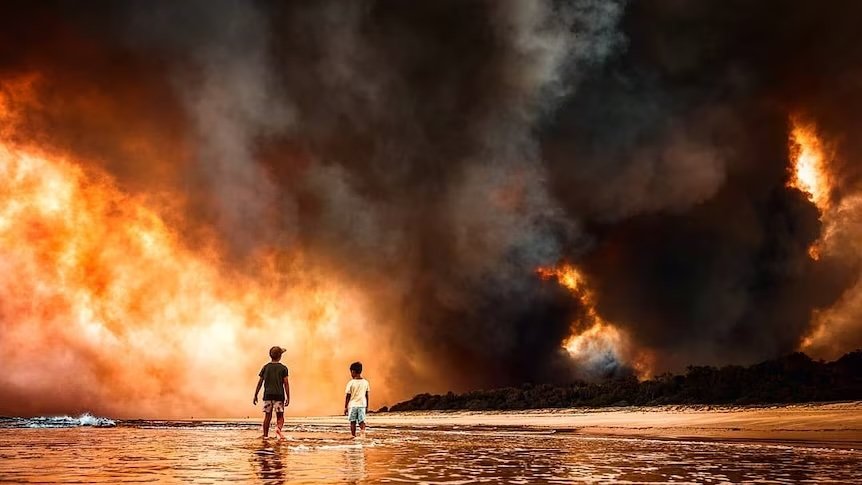Understanding the social impacts of climate change
When we think about climate change, the conversation often stops at the environmental layer—floods, fires, heatwaves, rising seas. These impacts are real, devastating, and growing in frequency and scale.
Equally important is what happens next. It’s what happens when a renter in Western Sydney can’t cool their home. When schools shut down for smoke days. When families are forced to relocate—not once, but repeatedly—and the support systems around them slowly unravel.
These are the social impacts of climate change. And they’re not abstract or far off. They’re shaping how people live, who adapts, who gets through crises, and who is left behind.
Why the social lens matters
Social impacts aren’t a side effect of climate change—they are central to how it is experienced. When the systems we rely on every day—housing, health, energy, community services—are already under pressure, climate disruption becomes a force multiplier. It pushes vulnerable households closer to the edge and exposes long-standing inequities.
Understanding these impacts isn’t about "soft" policy. It’s about planning better. Because when the social dimension is overlooked, resilience efforts miss the mark—and recovery becomes slower, costlier, and less inclusive.
The social impacts of climate change in Australia
Source: ABC website
Housing and shelter insecurity
1 in 25 homes in Australia could be uninsurable by 2030 due to a lack of climate readiness. In some places like Shepparton, it could be nearly 9 in 10 homes (The Guardian, 2025).
Renters face higher exposure to heat and poor-quality housing but have less control over adaptation.
Rising insurance premiums and unaffordable rebuild costs deepen housing insecurity post-disaster.
Health and mental wellbeing
Heatwaves are Australia's deadliest natural hazard, especially for older adults and those with chronic illness.
Psychological impacts are also rising—94% of psychologists report concern about climate-related mental health impacts (APS, 2024)
Projections from the University of Adelaide suggest a 50% increase in climate-driven mental and behavioural disorders by 2050 (University of Adelaide, 2025).
Financial and food stress
Energy and grocery costs are rising as climate events strain supply chains and grid reliability (The Australia Institute, 2025).
Households in heat-stressed suburbs face skyrocketing bills but limited ability to cool homes or relocate.
Casual workers often lose income during disasters, without safety nets.
Community disruption and loss of place
84% of Australians have been directly affected by a climate disaster since 2019 (Climate Council, 2024)
Displacement after fires or floods fractures communities, disrupts informal care networks, and accelerates social isolation.
Cultural sites and local gathering places are often lost without recovery plans.
Education and work disruption
School closures due to bushfires, smoke, floods, or extreme heat have affected student learning and parent workforce participation.
Remote and regional students face disrupted access to consistent education, exacerbating educational inequality.
Employment is increasingly disrupted in climate-exposed sectors like agriculture, tourism, and outdoor trades.
Widening inequality
Climate change exacerbates structural disadvantage—impacting First Nations peoples, women, migrants, and people with disability most.
Many recovery programs prioritise homeowners, leaving renters and undocumented residents behind.
Public policy responses still often ignore compounding vulnerabilities.
Breakdown of care and informal support systems
Carers face increased load during disruptions—especially women, grandparents, and informal support networks.
Volunteer fatigue is becoming a structural risk as communities face back-to-back climate disruptions with little recovery time.
Ageing populations and people with disability are left more isolated when support systems falter.
Governance and trust
When disaster responses are slow, inequitable, or poorly communicated, trust in institutions erodes.
Perceptions of "climate winners and losers" rise if resources are distributed inequitably or if lived experience is ignored.
Planning decisions that overlook community voice risk disengagement and opposition.
These are not future risks — they’re present realities
The social impacts of climate change are already shaping lives across Australia. They’re intensifying in regional communities and outer suburbs, deepening in vulnerable groups, and revealing the limits of systems we once took for granted.
But here’s the good news: these impacts are not inevitable. With foresight, policy alignment, and strategic investment, they can be addressed. But that means naming them clearly and planning for them proactively.
Planning for social resilience: what needs to change
Addressing the social impacts of climate change isn’t about patching up the fallout. It’s about embedding resilience into how we design communities, services, infrastructure, and support systems.
In my follow up article, I will cover:
Why social infrastructure should be treated as essential climate infrastructure
What it means to build climate resilience with equity at its core
And how planners, policymakers, and governments can centre people in every stage of climate adaptation.
If we want resilient places, we need resilient people—and, as always, this means keeping people front and centre of the work that we do.
Want to find out more? Or can we help shape your next project? Reach out to Liesl Codrington, Director Vaere Social, for a chat (liesl@vaeresocial.au).


